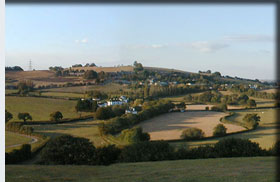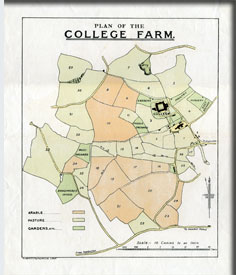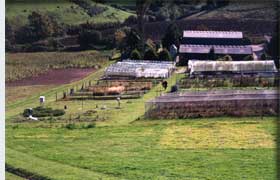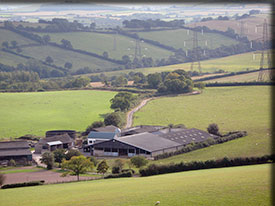November 2002 .. .. |
|||||||||||||||||||||||||||||
 Late in the afternoon of November 11th 2002 unsuspecting staff and students at Seale-Hayne thronged out of their afternoon lectures and meetings. They found e-mails and press releases awaiting them announcing the relocation of their activities to Plymouth. Although this, and the restructuring of the university as a whole, was couched in terms of a discussion document with a consultation period of one month it was fairly clear that the decision had been made. The Vice Chancellor was obviously determined and probably appointed to see the proposals turned into reality. He talked of academic synergy, cognate disciplines, cultural incubation and research excellence, all of which he said would materialise in a cultural quarter in the city of Plymouth. Sure enough the decision to restructure as proposed was made by the governors on 13th December 2002. The story of the university’s submission of an Omission in respect of Seale-Hayne to the Teignbridge Structure Plan in February 2002 then came to light. This, and the subsequent Concept Proposal showing plans for large-scale housing development on the farm, reveals a clear financial motive to have been in place before the restructuring announcements. Despite this, financial reasons were explicitly ruled out in statements in November 2002. Late in the afternoon of November 11th 2002 unsuspecting staff and students at Seale-Hayne thronged out of their afternoon lectures and meetings. They found e-mails and press releases awaiting them announcing the relocation of their activities to Plymouth. Although this, and the restructuring of the university as a whole, was couched in terms of a discussion document with a consultation period of one month it was fairly clear that the decision had been made. The Vice Chancellor was obviously determined and probably appointed to see the proposals turned into reality. He talked of academic synergy, cognate disciplines, cultural incubation and research excellence, all of which he said would materialise in a cultural quarter in the city of Plymouth. Sure enough the decision to restructure as proposed was made by the governors on 13th December 2002. The story of the university’s submission of an Omission in respect of Seale-Hayne to the Teignbridge Structure Plan in February 2002 then came to light. This, and the subsequent Concept Proposal showing plans for large-scale housing development on the farm, reveals a clear financial motive to have been in place before the restructuring announcements. Despite this, financial reasons were explicitly ruled out in statements in November 2002. |
|||||||||||||||||||||||||||||
How did it happen? |
|||||||||||||||||||||||||||||
The University of Plymouth gains control of the Seale-Hayne Charity |
|||||||||||||||||||||||||||||
 In 1989, Seale-Hayne College joined other South-West colleges and with Plymouth Polytechnic formed the new University of Plymouth. Unlike the other colleges, Seale-Hayne was a charity so the charitable scheme controlling the “Seale-Hayne College Trust” was re-drafted by the Charity Commission, making the University the Trustee of that Charity. Deliberately built into the 1989 scheme was Clause 10 stating that any decision regarding the assets that belonged to the Charity (in effect, the Seale-Hayne estate) had to be decided by the ‘Seale-Hayne Faculty Council’. This council was already in existence within Seale-Hayne College and was in effect, the previous Governing Body of the College. As constituted at that time, this Faculty Council was sufficiently independent of the University to be the correct body to safeguard the substantial assets of the Charity. In 1989, Seale-Hayne College joined other South-West colleges and with Plymouth Polytechnic formed the new University of Plymouth. Unlike the other colleges, Seale-Hayne was a charity so the charitable scheme controlling the “Seale-Hayne College Trust” was re-drafted by the Charity Commission, making the University the Trustee of that Charity. Deliberately built into the 1989 scheme was Clause 10 stating that any decision regarding the assets that belonged to the Charity (in effect, the Seale-Hayne estate) had to be decided by the ‘Seale-Hayne Faculty Council’. This council was already in existence within Seale-Hayne College and was in effect, the previous Governing Body of the College. As constituted at that time, this Faculty Council was sufficiently independent of the University to be the correct body to safeguard the substantial assets of the Charity.
In 1993/94, the University decided to disband all the faculty councils of its newly acquired partner colleges. However, it found that because of the charitable status of the College and the legally recognised role of its own faculty council, the University could not disband the Seale-Hayne Faculty Council. After many heated debates between the University Chancellery and the Faculty Council and a disputed vote, the University Vice Chancellor and his Governors eventually reconstituted the Seale-Hayne Faculty Council to become a committee of the Board of Governors of the University, consisting of just five members who were to be appointed by the Governing Body. It is argued that this reconstitution directly impacted on the 1989 scheme controlling |
|||||||||||||||||||||||||||||
The University acquires the freehold of Seale-Hayne’s estate |
|||||||||||||||||||||||||||||
 Appointed by the University Governors to this revised Faculty Council in 1994 was a very elderly Chairman alongside two “independent” people (with no knowledge of the recent history of the Charity but associated with Seale-Hayne) and two people with close links to the University, one of whom had to resign after the first meeting because of a ‘conflict of interest’. Appointed by the University Governors to this revised Faculty Council in 1994 was a very elderly Chairman alongside two “independent” people (with no knowledge of the recent history of the Charity but associated with Seale-Hayne) and two people with close links to the University, one of whom had to resign after the first meeting because of a ‘conflict of interest’.
It is alleged, and in hindsight it appears, that the “dumbing down” of the original Faculty Council was a deliberate move by the University in its attempt to gain control of the assets of the Charity, namely the 450-acre Seale-Hayne estate. After few vague meetings, some confusing information and some good lunches organised by the University Vice Chancellor’s office, it was this new Faculty Council that in 1999 eventually ‘agreed’ under clause 10 of the 1989 scheme to the change of ownership of the Seale-Hayne Charity’s assets that the University wanted. After consultation with the University, the Charity Commission ratified a new scheme under which the University of Plymouth gained the freehold of all the assets of the Seale-Hayne College Trust, in return for depositing a sum of money (circa £750,000) into a new charitable trust that became the “Seale-Hayne Educational Trust”. |
|||||||||||||||||||||||||||||
The University closes the College and puts the estate on the market |
|||||||||||||||||||||||||||||
 In 2002 and within 3-years of achieving ownership of the estate, the University had decided to close Seale-Hayne College and submitted fully worked up plans for substantial development over its newly acquired land to the local district council. In 2002 and within 3-years of achieving ownership of the estate, the University had decided to close Seale-Hayne College and submitted fully worked up plans for substantial development over its newly acquired land to the local district council.
The money invested by the University into the new Seale-Hayne Educational Trust in exchange for the freehold had by now already been repaid with the sale of the farm livestock and machinery and Seale-Hayne’s Daracombe Hall, a manor house in Highweek. In 2005, the University put the whole of Seale-Hayne onto the open market. By this time, the Seale-Hayne Future Group (SHF) was very active in examining the legality of the transfer of the charitable assets of Seale-Hayne. The group was also pressurising the University (through direct consultation and via various media) into careful consideration of a possible new owner and mounting opposition to the plans for development over the farmland. Several business proposals were drawn up for the site in the ensuing years, some in collaboration with the SHF group and all of them closely scrutinised, but none of them seemed to interest the University. In 2009, the University eventually agreed to a sale, splitting the site three ways. The farmland was purchased by a local farmer, the housing stock and some further land purchased by a developer and the College buildings with 80-acres purchased by the Dame Hannah Rogers Trust (DHRT), a charity that specialises in the care of young adults with profound special needs. However, DHRT (latterly “Hannahs”) struggled to finance their purchase of Seale-Hayne and realised in 2018 that they regrettably had to sell to be able to maintain their core care business based in Ivybridge. In 2019, this part of the College was bought by European Land Group and marketed as a ‘business hub’, with many of the rooms and buildings available for rent to business enterprises. |
|||||||||||||||||||||||||||||
Development Plans |
|||||||||||||||||||||||||||||
| Teignbridge District Council’s long term planning document approved in 2014 has earmarked some of the Seale-Hayne farmland for housing development, with developers constantly pressing to take even more of the land than was originally allocated in the agreed area. The SHF group is making representation whenever appropriate to try and prevent the whole estate from disappearing under a sea of houses.
It is understood that in the sale contracts, Plymouth University retained the financial ‘uplift’ should any of the estate be sold for development. |
|||||||||||||||||||||||||||||
The Future |
|||||||||||||||||||||||||||||
| Because of this questionable chain of events and the obvious financial gain that the University of Plymouth has achieved (and might achieve further) from closing and subsequently selling Seale-Hayne College, many people feel that to retain a shred of dignity in this affair, the University of Plymouth would do well to divert a substantial part (if not all) of the eventual sale proceeds back into the current Seale-Hayne Educational Trust. The Trust would then be in a position to offer even greater substantial awards than it does already to further research associated with the subjects in which Seale-Hayne College used to excel. | |||||||||||||||||||||||||||||
Documents |
|||||||||||||||||||||||||||||
| The following documents relate to the history of the closure from 2002 onwards and go a long way to explaining the sequence of events and some of the feelings of those involved. Please feel free to contact us if you wish to add your thoughts. | |||||||||||||||||||||||||||||
|
|||||||||||||||||||||||||||||
© The Seale-Haynians.
 Proudly Powered by WordPress | Nest Theme by YChong
Proudly Powered by WordPress | Nest Theme by YChong
